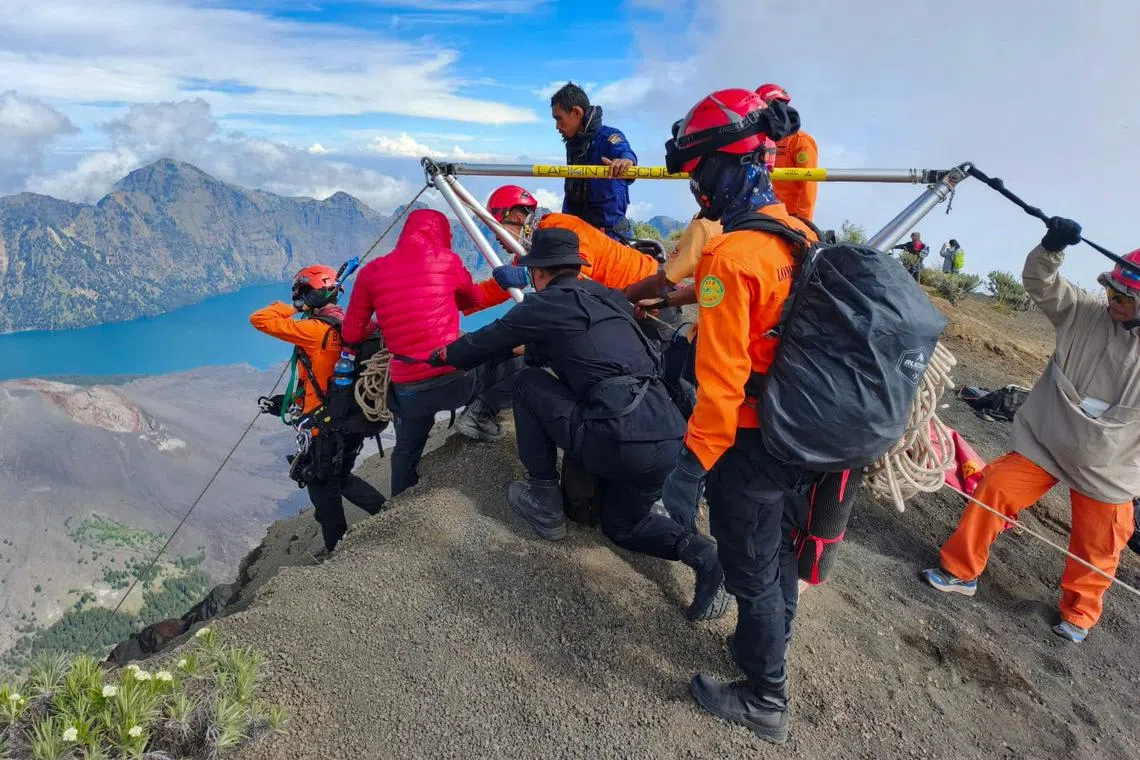‘Worst incident in my 15-year career’: Rescuer who found Brazilian tourist’s body on Lombok volcano
Sign up now: Get ST's newsletters delivered to your inbox

The complex five-day rescue operation was plagued by poor visibility and rain.
PHOTO: AFP
Follow topic:
SINGAPORE - It took two aborted attempts in freezing temperatures before rescue worker Khafid Hasyadi climbed a 180m vertical cliff face and retrieved the body of a Brazilian tourist from a ravine on Mount Rinjani in Lombok.
It then took him and his team another five hours to come down from the mountain, putting an end to a five-day rescue operation plagued by poor visibility and rain.
Bad weather conditions were a key reason why the authorities could not dispatch a helicopter to do a search and rescue for the tourist, Ms Juliana Marins.
When Mr Khafid first embarked on the search-and-rescue effort on June 21, he fought through heavy fog and rocky terrain to climb Mount Rinjani – Indonesia’s second-highest peak at 3,726m – to get to her.
He said: “This was the worst incident I have seen in my 15-year career. The fog was impenetrable and with the terrain on the cliff, it was impossible for us to fight the environment and get to her sooner.”
Ms Marins, 26, was on an early morning hike with five friends on Mount Rinjani
She survived the initial fall, and drone footage and video clips recorded by other hikers showed that she was distressed, but alive, in a ravine at a depth of 150m.
But when rescuers descended the ravine, going twice as deep, they could not find her.
By the morning of June 22, drone footage showed she was no longer in the same place, and rescuers could not find her even 300m into the ravine.
Climate conditions and extreme terrain slowed down efforts.
But the search resumed on June 24 and rescuers finally reached her body after descending 600m, Indonesia’s search and rescue agency said in a statement.
Ms Marins’ family later criticised the rescue effort
Mr Khafid, speaking to The Straits Times from Indonesia, said he and his team heard about Ms Marins’ fall at about 11am on June 21 and set off on foot to find her on Mount Rinjani.
Carrying rescue equipment weighing about 10kg, he reached the location where she was last seen at about 11pm, but by then, it was too dark to do anything.
The next day, bad weather hindered rescue efforts.
He said: “We couldn’t even see 5m ahead because of how thick the fog was.
“From morning till evening, the weather was against us, and we had to leave our equipment there and trek down to the foot of the volcano.”
At about 7.05am on June 23, a thermal drone detected Ms Marin and Mr Khafid started to descend into the ravine. She was spotted at a depth of about 400m, but by the time he got there, she was not to be found.
Mr Khafid radioed back to his team – made up of 48 members – and prepared to descend farther, but heavy fog returned and forced him to stop.
It was on the third attempt that he descended to about 600m and found her.
A certified medical first responder, he checked and found that Ms Marins was dead. He relayed the information back to the other rescuers, who were volunteers and officers from several Indonesian agencies.
Six other men descended into the ravine. Three were stationed at the 400m mark, while the other three joined Mr Khafid.
On their way down, they set up anchor points on the cliff face, taking care to position them on rocks for added stability.
But by the time they reached Ms Marins, it was dark and they slept while tethered to the cliff face, making the decision to carry out the evacuation the next day.
Deploying a helicopter to airlift Ms Marins was considered, the Rinjani National Park Office said in an Instagram post on June 24, but the heavy fog ruled out such a move.
At 6am on June 25, rescuers began preparing her for evacuation and nearly eight hours later, she was pulled out of the ravine and up a 180m vertical cliff face. The rescuers then came down the mountain with her body.
An autopsy was conducted on June 26 and Ms Marins’ body was headed to Bali for repatriation to Brazil, Indonesian media reported.
Asked if he had any advice for people keen on climbing Mount Rinjani, a popular tourist site, Mr Khafid said it was important not to take the elements lightly.
“The best time to climb it is from August to September, when the weather is good,” he said. “If the weather is bad, it is better not to attempt it because we cannot fight the elements. We can only avoid them.”
He said he regretted how the operation turned out, and added that things could have turned out differently if the weather conditions had not been as harsh.
“You can use the best and latest equipment to do things like determine a person’s location through the fog,” he said.
“But at the end of the day, it is up to the rescuers to do the actual work, and we have our limitations. If nature is unfriendly, there is little we can do, and so I have my regrets.”
Aqil Hamzah is a journalist covering breaking news at The Straits Times, with interests in crime and technology.


